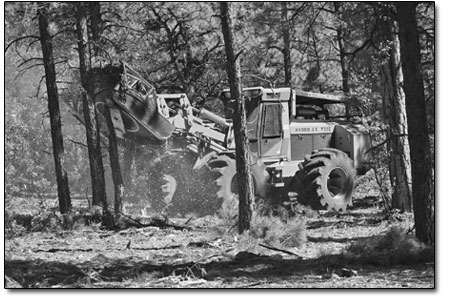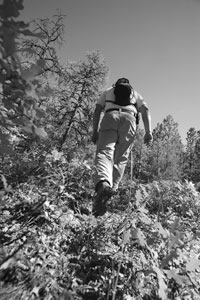|
| ||||
| Animas Mountain Revisited
by Missy Votel
“What we found using the smaller tracked equipment was whenever the machines had to make tight turns, it would cause quite a bit of soil disturbance,” said Bill Dunkelberger, Associate Manager of the San Juan Public Lands Center. Furthermore, the minimowers were less powerful at mulching and required multiple passes to clear areas of the thick forest, making for even more soil disturbance and erosion. “The contractor saw what was happening and said, ‘This is not good,’ so we stopped work,” said Dunkelberger. “We were doing as much harm as good.” As a result, the BLM went back to its original plan to use two larger hydro-axes, wheeled machines that use a large spinning drum with carbide teeth to shred small trees and brush. “The hydro-axes are able to swivel around, whereas the tracks of the mini-mowers just dragged and pushed the dirt around,” said Matt Janowiak, Columbine District BLM field manager. However, earlier speculation that trails would have to be widened to accommodate the 8-foot wide machines turned out not be the case, Dunkelberger said. Both machines were brought up to the lower flanks of the mountain on Monday using the existing trail, a former doubletrack, with little impact other than the removal of a few large rocks. “We walked them up from the 32nd Street trailhead, and the machines were narrow enough to fit on the trail,” he said. Janowiak said it is his hope that trail users will not even be able to tell the machines were on the trail come next summer. Despite the use of the hydro-axes, thinning within 100 feet of the trail will still be done by hand crews. Crews actually started working on the trail corridor earlier this4 summer, Dunkelberger said, but trail users may encounter temporary closures due to safety concerns. “Obviously, if we’re dropping trees near the trail, we don’t want people riding bikes or hiking nearby,” he said. Any closures will likely be signaled by a stationed crew member on the trail. As for the hydro-axes, they should have no direct impact on trail users, other than noise. According to Janowiak, about 800 acres of forest will be thinned, mostly juniper and scrub oak. He said the forest should have a natural fire-recurrence history of 13-25 years. However, thanks to modern human fire suppression, Animas has not had a large burn in more than a century. The result is an abundance of fuels, mostly large junipers and dead scrub oak, which could have devastating effects should the mountain ever burn. “We will be taking out most all of the juniper and a substantial amount of oak brush where the upper branches are dead,” Janowiak said. “Even a low-intensity fire should’ve burned that out years ago.”
The goal of the fuels-mitigation project is to create a “defensible space” whereby any fires would be confined to the forest floor, thus allowing fire crews to fight on the ground using fire lines and conventional methods. “Canopy fires are too dangerous to fight on the ground. The only way to attack them is from the air with slurry drops,” said Dunkelberger. One local example of such a fire-mitigation approach is at Twin Buttes, which Dunkelberger visited recently. “It looks very good and doesn’t stand out,” he said. “Once it greens up next summer, you won’t be able to tell.” Following the catastrophic wildfire season of 2002, the Bush Administration created the National Fire Plan. Among the plan’s mandates was that the Forest Service and BLM thin trees in the wildland-urban interface. In response, San Juan Public Lands has treated numerous areas surrounding Durango, using either prescribed burns, hand thinning or hydro-axes. Early in 2007, the BLM announced that Animas Mountain would go under the blade. The predominantly BLM land is surrounded on three sides by homes and was identified in the La Plata County Community Fire Plan as an area of high risk. “Animas Mountain is one of the most important areas around Durango in terms of mitigating for fire danger,” Shawna Legarza, Fire Management Officer and the BLM’s project leader, said at the time. “Homes would be threatened, the mountain would be ruined aesthetically, and we’d be dealing with impacts from run-off and erosion for decades,” she said of the possible effects of a wildfire. The BLM’s original plan entailed treating the mountain with hydro-axes and widening a large piece of the trail into a road. This incited strong public reactions, resulting in the minimower alternative, announced last spring. Mary Monroe, executive director of Trails 2000, which was supportive of the use of minimowers, said despite the last-minute change in equipment, the impacts on trail users will likely be the same with the minimower as the hydro-axe. “The BLM still plans to hand thin close to the trail, and the effects to the trail user will be minimal,” she said. She also said having the heavier equipment on the mountain could create an opportunity to restore water bars on the backside of the mountain, which were originally built using heavy machinery. “This could help with erosion and user experience on that steep road,” she said. Janowiak said fire mitigation on Animas should be completed by the time the snow flies this winter, and slash piles from the hand crews will be burned next spring. And if all goes as planned, crews really will return next time only for a light touch-up. “The nice thing is, next time we have to go up, in 10 years or so, it will really be with a light touch. We’ll be able to leave the juniper and the thick ponderosa pines.”
|
In this week's issue...
- January 25, 2024
- Bagging it
State plastic bag ban is in full effect, but enforcement varies
- January 26, 2024
- Paper chase
The Sneer is back – and no we’re not talking about Billy Idol’s comeback tour.
- January 11, 2024
- High and dry
New state climate report projects continued warming, declining streamflows



 After much debate, it seems the hydro-ax will fall on Animas Mountain after all. Despite taking what was hoped to be the “lighter and gentler” approach to fuels-reduction on the popular recreation area, ground crews have discovered that the smaller mini-mowers were actually taking a bigger bite out of the mountain than expected.
After much debate, it seems the hydro-ax will fall on Animas Mountain after all. Despite taking what was hoped to be the “lighter and gentler” approach to fuels-reduction on the popular recreation area, ground crews have discovered that the smaller mini-mowers were actually taking a bigger bite out of the mountain than expected.